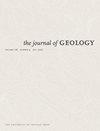Deformation Structures in a Large Slump Horizon, Paleoproterozoic Vempalle Formation, Cuddapah Basin, Southern India
IF 1.3
4区 地球科学
Q2 GEOLOGY
引用次数: 0
Abstract
Occurrence of slump folds and associated faults generated by soft-sediment deformation from the Paleoproterozoic Vempalle Formation, southwestern Cuddapah basin, India, is being reported here for the first time. The slump horizon is preserved within a more or less undeformed shallow to deep-water carbonate unit in the Cuddapah basin exposed near Parnapalle village, Andhra Pradesh, India. The stratigraphic framework includes the Gulcheru Quartzite, lowermost unit of the Cuddapah basin succession, deposited in an alluvial to shallow marine shelf environment, and the overlying Vempalle Formation, representing a ramp-type stromatolitic carbonate platform. The synsedimentary sliding along a steepened ramp is evidenced by northeast-verging kink-like folds with wavelength up to 400 m and an overprinting set of thrusts with ramp-flat geometry, fault-cored folds or small break-thrusts showing top-to-southwest displacement, and smaller congruent folds. From the isolated occurrence within a generally undeformed succession, association of structures, and the stratigraphic context, we suggest soft-sediment deformation at the toe of a large (kilometer-scale) slump, with the prevalent bedding-parallel anisotropy exploited for common flexural slip and ramp-flat geometry. In addition, the bedding-parallel slickensides in the Gulcheru Quartzite immediately below the Vempalle Formation indicate a top-to-east-northeast, normal sense of slip representing extensional slip at the slump head. Northeast-verging large folds in the Parnapalle slump horizon possibly represent structures formed during the translation phase of slumping. As the large northeast propagating slump was halted, the backthrust-like structures and associated folds developed at the slump toe.印度南部Cuddapah盆地古元古代Vempalle组大滑塌层位的变形构造
本文首次报道了印度Cuddapah盆地西南部古元古代Vempalle组软沉积变形形成的滑塌褶皱及其伴生断裂。在印度安得拉邦Parnapalle村附近的Cuddapah盆地,滑塌层被保存在一个或多或少未变形的浅水到深水碳酸盐岩单元中。地层格架包括Gulcheru石英岩和Vempalle组。Gulcheru石英岩是Cuddapah盆地演替的最底层单元,沉积于冲积-浅海陆架环境;Vempalle组为斜坡型叠层石碳酸盐岩台地。沿陡坡方向的同沉积滑动主要表现为波长达400 m的东北向边缘绞扭褶皱和一套斜平形状的叠印逆冲构造、由上至西南位移的断芯褶皱或小断裂逆冲构造以及较小的同向褶皱。从一般未变形演替中的孤立产状、构造关联和地层背景来看,我们认为软沉积变形发生在大型(千米尺度)滑塌的趾部,普遍的层理平行各向异性被用于常见的弯曲滑动和坡道平坦几何。此外,在Vempalle组下方的Gulcheru石英岩中,层理平行滑面表明滑塌头处有自顶至东-东北方向的正常滑动,代表滑塌头处的伸展滑动。帕纳帕尔滑塌层位东北向的大褶皱可能是滑塌平移期形成的构造。随着大规模向东北扩展的滑塌停止,滑塌趾发育逆冲构造及相关褶皱。
本文章由计算机程序翻译,如有差异,请以英文原文为准。
求助全文
约1分钟内获得全文
求助全文
来源期刊

Journal of Geology
地学-地质学
CiteScore
3.50
自引率
5.60%
发文量
0
审稿时长
3 months
期刊介绍:
One of the oldest journals in geology, The Journal of Geology has since 1893 promoted the systematic philosophical and fundamental study of geology.
The Journal publishes original research across a broad range of subfields in geology, including geophysics, geochemistry, sedimentology, geomorphology, petrology, plate tectonics, volcanology, structural geology, mineralogy, and planetary sciences. Many of its articles have wide appeal for geologists, present research of topical relevance, and offer new geological insights through the application of innovative approaches and methods.
 求助内容:
求助内容: 应助结果提醒方式:
应助结果提醒方式:


